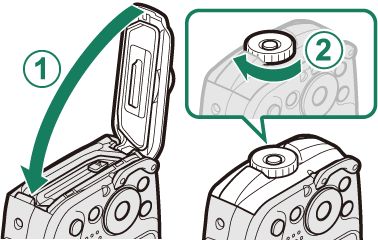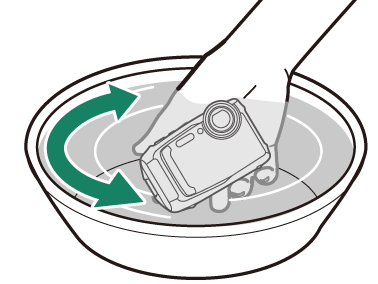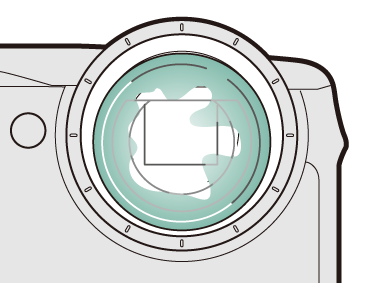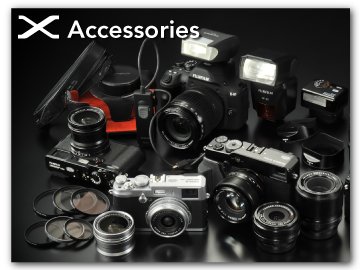Product Features and Precautions for Use
Water, Dust, and Shock Resistance
The camera complies with JIS Class 8 water resistance and JIS Class 6 (IP68) dust resistance standards, and has passed Fujifilm drop tests (drop height: 1.80 m/5.9 ft.; impact surface: plywood, thickness 5 cm/2.0 in.) compliant with MIL-STD 810F Method 516.5: Shock. These results were obtained through in-house testing and are not a blanket guarantee of water resistance or invulnerability to damage or destruction. The accessories supplied with the camera are not water resistant.
Before Use
-
Inspect the water-resistant seal and adjacent surfaces and remove any dust, sand, or other foreign matter using a soft, dry cloth.

Have the water-resistant seal replaced if it is deformed or otherwise damaged (note that a fee is charged for this service; contact your retailer or a Fujifilm-authorized repair technician for more information). Failure to replace the seal could result in leaks and damage to the camera.
-
Holding the battery-chamber cover closed against the camera body (A), rotate the latch until it clicks into place (B), indicating that the cover is secure.

-
Check that the cover is secure by rotating the latch in the opposite direction and confirming that the cover does not open.
The front surface of the camera lens is protected by a sheet of glass. Foreign matter on the glass will appear in photographs; keep the glass clean at all times.
Be sure that the battery-chamber is fully latched. The presence of water, mud, or sand in the camera could cause malfunction.
Do not open or close the battery-chamber cover with wet hands or in locations that are dusty, sandy, or near water, for example while on or by a body of water.
Be sure the camera is completely dry before inserting or removing batteries or memory cards or connecting the USB or HDMI cable.
The camera does not float. Be sure to attach the strap and keep it around your wrist when using the camera.
During Use
Restrict underwater use to depths of 25 m (82 ft.) or less and periods shorter than 120 minutes. Clean and dry the camera within one hour of using it underwater.
The interior of the camera is not waterproof. Do not open or close the battery-chamber cover while under water. After cleaning the camera, be sure it is completely dry before opening or closing the battery-chamber cover.
Do not use in hot springs or heated pools.
The camera may lose water resistance if subjected to excessive force or vibration. Do not dive into water with the camera or otherwise subject it to excessive force. In the event the camera is subjected to strong physical shocks, contact your retailer or a Fujifilm-authorized repair technician.
If the camera is left on the sand, its temperature may exceed operating limits and sand may get into the speaker or microphone.
Sunscreen, suntan lotion, or other oily substances may discolor the camera body and should be removed with a damp cloth.
Note that the color of the supplied strap may fade or transfer to other items if it is exposed to moisture or friction.
After Use
Perform the following steps after using the camera underwater or in locations where foreign matter might adhere to the camera body.
-
Securely close the battery-chamber cover and rinse the camera under the tap or leave it in a basin of fresh water for about ten minutes.

-
Remove water from the camera with a soft, dry cloth and leave it to dry in a well-ventilated location in the shade.
-
After confirming that the camera has dried and is free of water droplets, open the battery-chamber cover and use a soft, dry cloth to remove any water, dust, or other foreign matter from the battery chamber.
Remove any foreign matter from the water-resistant seal and adjacent surfaces. Foreign matter could damage the seal, lowering water resistance.
Liquid soaps, detergents, alcohol, and other cleansers may affect water resistance and should never be used.
After use, remove water droplets and foreign matter with a dry cloth, firmly latch the battery-chamber cover, and soak the camera in fresh water for about ten minutes. Dry the camera thoroughly after removing it from the water.
Storage and Maintenance
Do not store at temperatures below 0 °C (32 °F) or above 40 °C (104 °F).
To ensure continued water resistance, it is recommended that you have the water-resistant seal replaced about once a year (a fee is charged for this service). Contact your retailer or a Fujifilm-authorized repair technician for more information.
Condensation Inside the Lens
In some environments, condensation (fog) may form inside of lens. This does not indicate a malfunction. Condensation can be removed by leaving the battery-chamber cover open in a location with a steady temperature that is free of heat, humidity, sand, and dust.

Condensation
Condensation is particularly likely to occur if the camera is placed in cold water after being exposed to high temperatures or taken from a cold to a warm environment or if the battery chamber is opened in a humid location.
Cold Climates
Battery performance drops at low temperatures, reducing the number of pictures that can be taken. Insulate the camera to keep it warm or place it in your clothing.
Use an NP-45S battery.
Display response may slow at low temperatures. This is not a malfunction.

 .
.

